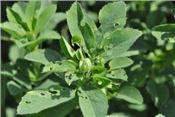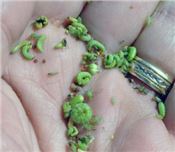Alfalfa Weevil, A Key Insect Pest On The First Alfalfa Cutting
DR. LEE TOWNSEND
LEXINGTON, KY.
Alfalfa weevil is a key insect pest on the first alfalfa cutting. Tip feeding should show up soon in established fields (Figure 1).
This insect occurs throughout the state, but sound management practices, weather patterns, and natural enemies often keep numbers below damaging levels in many fields.
Great natural mortality of alfalfa weevil can occur early in the weevil season. Strong winds and driving rain can knock small larvae (Figure 2) to the ground where they perish. In addition, alfalfa can tolerate light feeding by the insect with no appreciable loss of yield or quality.
Assessing fields for weevil activity can prevent unneeded insecticide applications. This not only saves money but preserves many of the important beneficial insects that build up in numbers early in the season.
Alfalfa weevil larvae feed for 3 to 4 weeks, chewing small holes in buds and expanding leaves. Moderate damage can give alfalfa a gray, frosted appearance; severe feeding can completely defoliate plants. These losses reduce the protein content and digestibility of the valuable first cutting.
Management Options
Early harvest is a good control option if alfalfa is in the late bud stage or the first flowers have opened. This may be particularly useful in 2015 because alfalfa growth may have a jump on weevil activity due to the cold winter. Many weevil larvae die during harvest and the curing process as a result of exposure to hot sun and low humidity, along with lack of fresh plant tissue. If this strategy is used, then watch the re-growth closely to make sure that there are not enough surviving larvae or adults to feed on emerging tissue in the crowns. Stubble defoliation can last for up to 3 days without a significant effect. However, if stubble feeding continues for 7 to 10 days after harvest, plant development will be delayed. A stubble spray should be applied if re-growth is being damaged significantly (40 percent or more stems with feeding scars).
Insecticides can provide quick knockdown of potentially damaging weevil populations if the crop will not be ready for harvest for a week or longer, and potentially damaging levels of larvae are present. Control options for alfalfa pests are listed in, Insecticide Recommendations for Alfalfa, Clover, and Pastures (ENT-17). Check labels carefully for harvest intervals to select products and rates that will avoid unacceptable residues.
Biological control plays an important role in regulating alfalfa weevil numbers. Several parasitic wasps have become established in the state and provide an important level of natural control. Unfortunately, the impact is difficult to assess when weevil larvae are actively feeding on the crop. These wasps can be protected by applying an insecticide only when weevil numbers exceed the recommended treatment guidelines. ∆
DR. LEE TOWNSEND: Extension Entomologist, University of Kentucky

Figure 1. Tip feeding by alfalfa weevil larvae.
Photos: Lee Townsend, UK

Figure 2. Several sizes of alfalfa weevil larvae.